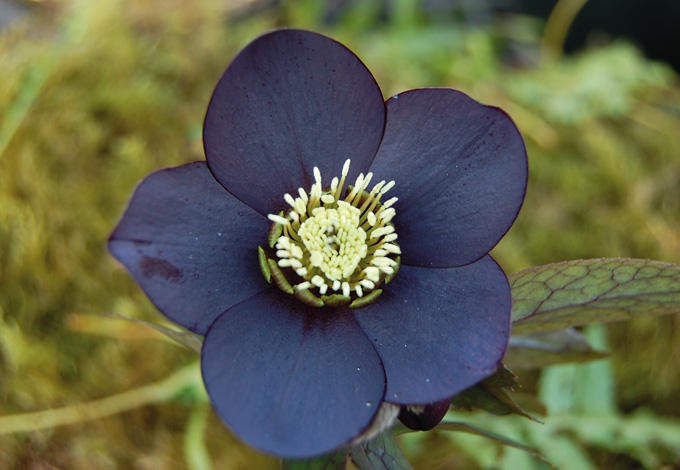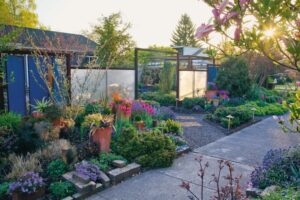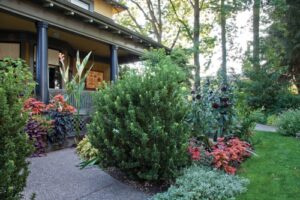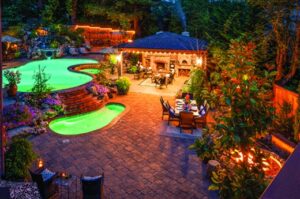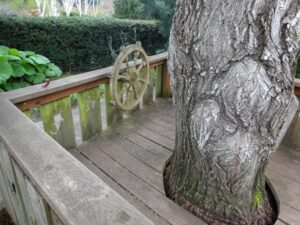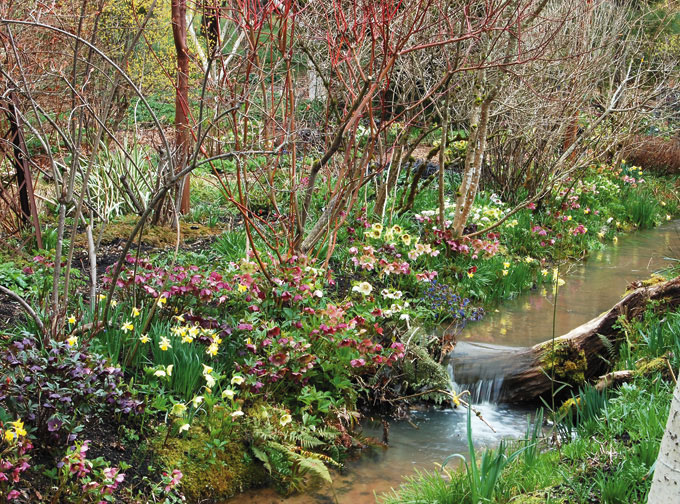 |
|
Above: Naturalized hellebores mingle with daffodils on the banks of a vernal stream alongside the driveway at Marietta and Ernie O’Byrne’s Eugene property. Below: Marietta and Ernie O’Byrne opened the Northwest Garden Nursery in 1992. |
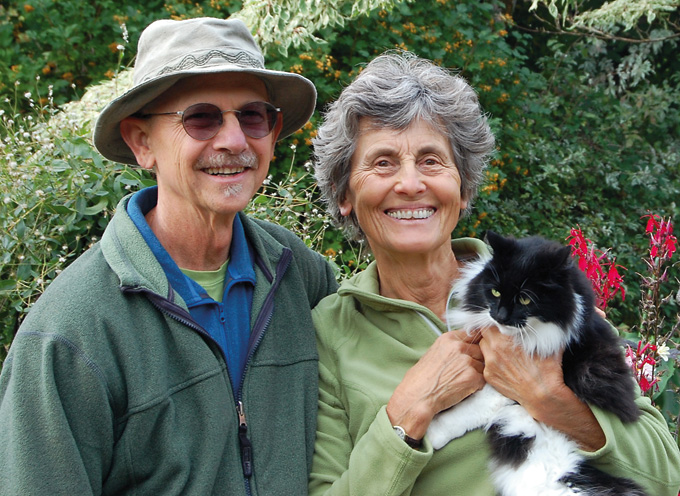 |
Gardener’s fall prey to plant lust with alarming regularity. I always laugh when asked to name the plants on my Top 10 hit parade. My stock reply is: “I have a different favorite every day.” Truth be told, one seductive genus is my all-time No. 1: helleborus. The species forms have their own allure, but it is the hybrids that hold me in thrall. Helleborus x hybridus are the jewels of the winter garden.
The plants are evergreen, hardy and shade tolerant with handsome, durable foliage; they bloom from January through April. Those are great attributes for any plant, but it’s the flowers that make me swoon. The newer hybrids offer a luscious array of colors and flower forms. Blooms in shades of jade green, amethyst, bubblegum pink, dusky maroon, blushing apricot, onyx, pristine white and butter yellow abound.
Before the renaissance in hellebore breeding, flowers were single, composed of five sepals that look like petals. Now double-flowered hellebores are de rigueur for shade-garden connoisseurs, as are semi-doubles. The sepals of many of the new hybrids look as if they have been enhanced by an artist’s brush overlaid with color, the subtle addition of a picotee edge or splashed with contrasting colored freckles.
Gardeners the world over have Eugene nursery owners Marietta and Ernie O’Byrne to thank for their role in creating this new generation of plants. In 1992, after 17 years as landscape gardeners in Eugene, the O’Byrnes opened Northwest Garden Nursery, specializing in hard-to-find and unusual plants not readily available in the trade. Their cachet as purveyors of exceptional plants grew as they traveled to regional plant sales and as more and more gardeners made the trip to visit their nursery and exquisite garden. Like other savvy gardeners, the O’Byrnes used hellebores to great effect as reliable, low maintenance evergreens in their shade gardens. They appreciated their precocious late winter, early spring bloom season and the longevity of the flowers which provide a bridge between the winter and spring garden. But the blooms, mostly white, pale pink and muddy shades of burgundy were not as colorful as other vernal beauties like daffodils.
It wasn’t until 1995 that Marietta’s interest in hybridizing hellebores was piqued by what European breeders were accomplishing. After seeing a photo of a red cultivar in a book by English hellebore collector and hybridizer Helen Ballard she was excited about trying her hand at hybridizing. Out of five seeds garnered from German nurserywoman Gisela Schmiemann, four germinated, providing the basis for the O’Byrnes’ breeding program. Plants from other European breeders helped expand the color palette of her lines.
Marietta focuses on plants that have clear, rich colors, up-facing flowers, vigor and resistance to black spot. “Increasing the color range and improving the form of double hellebores is our specialty,” interjects Ernie. All of the stock plants are hand-pollinated and then isolated from other pollinators. Seeds germinate in six months and seedlings bloom in their second year. Marietta is line breeding and doesn’t use tissue culture for plant production. As successive generations supersede their parent plants they are added to the breeding program and the older plants are dropped. She is ruthless, culling out any plants that won’t add to or strengthen the line. She removes plants that may be beautiful but inferior to their siblings. Her diligence is what makes her seed strains so sought after — they are pure and predictable. It is an onerous and exacting process but the results are extraordinary. The range of colors in both single- and double-flowered forms she has created has forever changed the landscape of hellebore breeding.
In 2008, Ernie and Marietta closed the retail nursery to focus on their breeding program and spend more time with family and garden. The garden, revered as an iconic example of Northwest regional style, is ever changing. “We grow anything we can get our hands on,” says Marietta, “vegetables, tiny alpines, colorful perennials and huge trees.”
The large vegetable and fruit garden supplies everything from greens to asparagus. They make juice from their berries and fruit trees. Nothing goes to waste; table and food scraps go the chickens, which in turn provide eggs and manure for the garden.
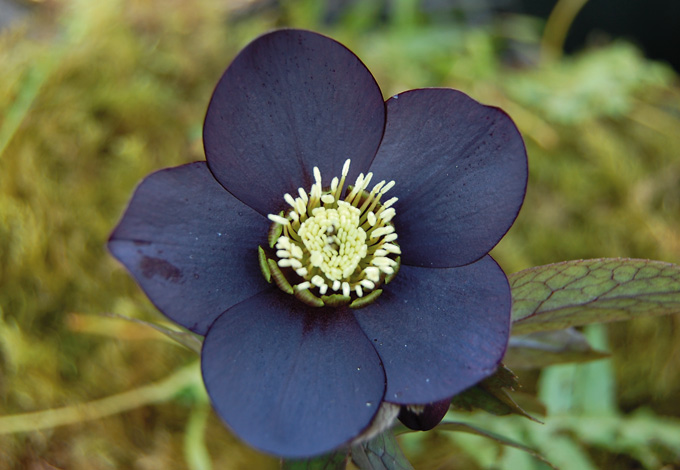 |
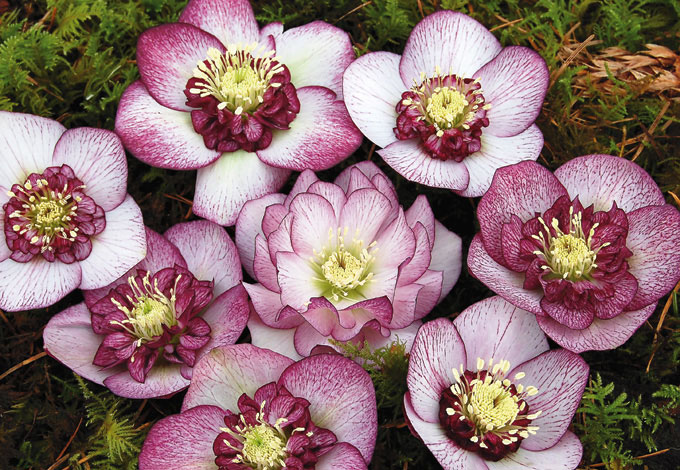 |
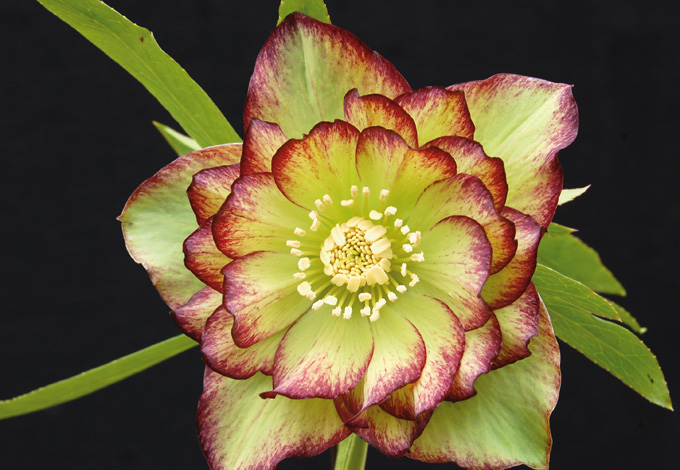 |
|
Flowers, left to right: a single dusky black in the black diamond group; anemone-flowered blooms in the cherry blossom series; lime-green sepals in the the jade tiger group. |
||
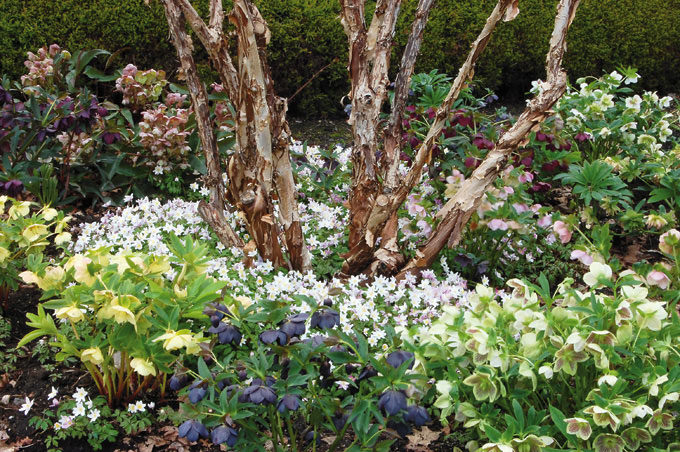 |
|
Above: Pools of hellebores interspersed with Primula sieboldii are a welcome sight in the O’Byrne garden in early spring. Below: Hellebores are the signature plants in the O’Byrne spring garden. Marietta contrasts different shades of white, red and black hellebores to attract the eye. |
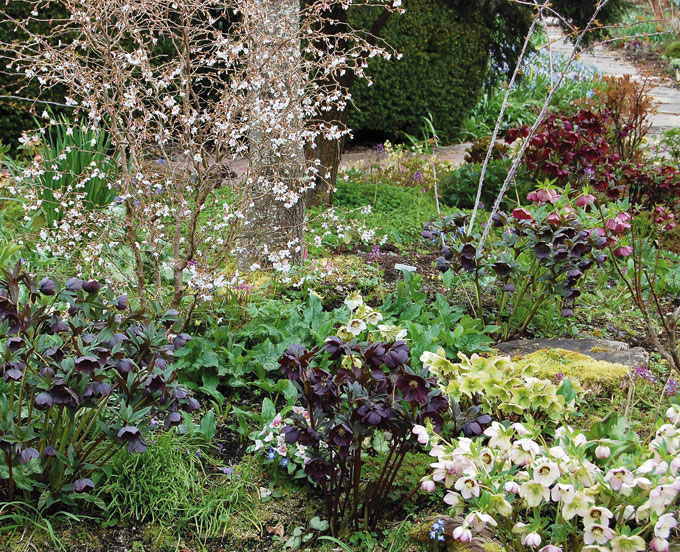 |
Perennial borders are extravagant and lush — the canvas for Marietta to paint with color, texture and form. Western natives are showcased in a part of the garden where the soil is lean and mean. Drought-tolerant oaks, manzanita, cactus, yucca and California poppies replicate the feeling of the chaparral. Dwarf conifers and denizens of alpine regions are displayed in a rock garden and troughs. Woodland understory plants from around the world thrive in the shade of venerable trees. Marietta likes a little “disorder in the garden, allowing plants to touch so that any editing goes unnoticed.”
Marietta and Ernie are humble and unassuming, willing to share their expertise with gardeners who share their passion for plants. Gardeners and nursery folk from around the globe make pilgrimages to their garden every year. Their dedication and passion have influenced countless gardeners and horticulturalists.
I don’t know about you but I see a road trip in my future. It’s time to rogue out some of my 30-year-old hellebores and replace them with Marietta’s beauties.
This year Marietta and Ernie O’Byrne are hosting their annual Hellebore Open Garden Days Feb. 18-19 and Feb. 25-26. You can also visit the garden by making an appointment. Visit northwestgardennursery.com for more details.



